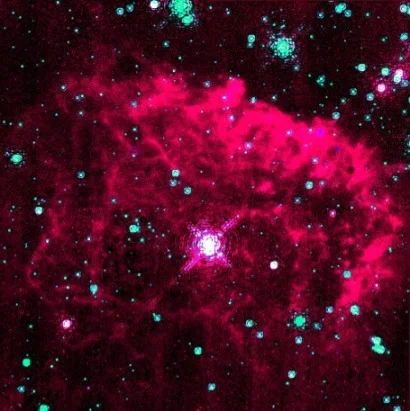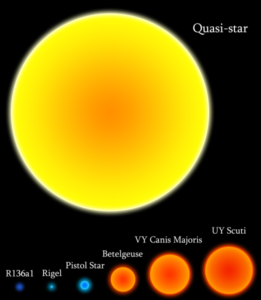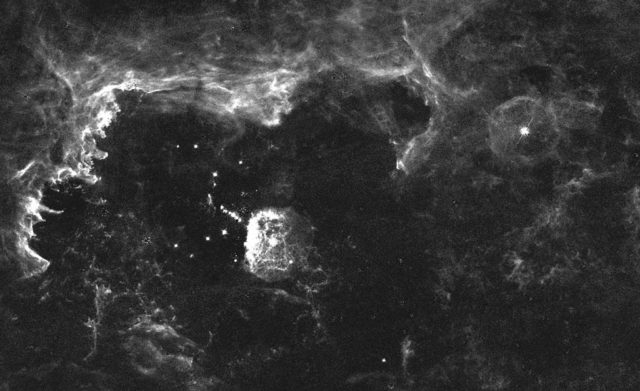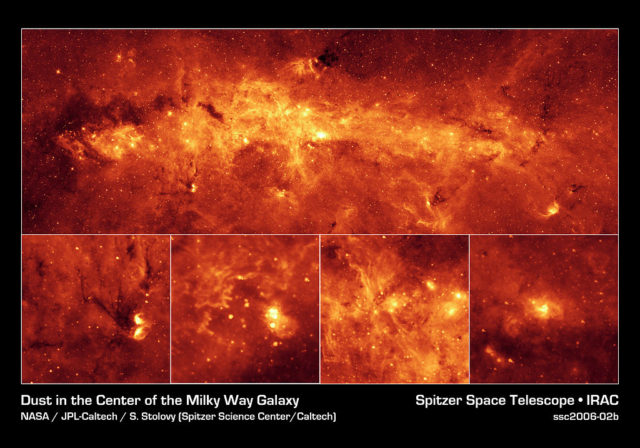The Pistol Star, also known as V4647 Sagittarii, is a blue hypergiant star located about 25,000 light years from Earth in the constellation Sagittarius. It is a candidate luminous blue variable (cLBV) and one of the most luminous stars known, with a luminosity 1,600,000 times that of the Sun.
Early observations indicated that it was the single most luminous star known, with an estimated luminosity almost 10 million times solar, but later studies reduced the estimate to about a third of the luminosity of Eta Carinae. The Pistol Star’s surface temperature is 11,800 K. Its absolute bolometric magnitude is -10.75.
The Pistol Star is the central star in the Pistol Nebula and was named after the nebula’s shape. It is a member of the Quintuplet Cluster and, like many other exceptionally massive and luminous stars in the cluster, it cannot be seen visually because it is obscured by the dust in the region of the Milky Way’s core. Without the interstellar dust and the surrounding nebulosity, the Pistol Star would be visible to the unaided eye, shining at 4th magnitude from a distance of 25,000 light years.

Pistol Star and Nebula (false colour composite image), photo: Don F. Figer (UCLA) and NASA
Facts
The star’s exact age is unknown, but estimated at 4 to 10 million years. The star will likely end its life in a supernova or hypernova event in the next 1 to 3 million years.lumin

Size comparison of a hypothetical quasi-star/black hole star (diameter of ~10 billion kilometers or ~7,187 solar diameters, mass of 1000+ solar masses) and several known giant stars: UY Scuti (~1708 solar diameters, ~7-10 solar masses), VY Canis Majoris (~1420 solar diameters, ~17 solar masses), Betelgeuse (~887 solar diameters, ~11.6 solar masses), the Pistol Star (~306 solar diameters, ~27.5 solar masses), Rigel (~78.9 solar diameters, ~23 solar masses), and R136a1 (~35.4 solar diamaters, ~265 solar masses). Image: Wikimedia Commons/Sauropodomorph
The Pistol Star is believed to have shed almost 10 solar masses of material in huge outbursts between 4,000 and 6,000 years ago. When the star formed, it likely had a mass more than 100 times solar, but now has a lot less as a result of ejecting a vast amount of material.
The star’s current mass is uncertain but, based on its spectrum, it is estimated to be 27.5 solar masses. The star’s radius is 306 times solar and its stellar wind is more than 10 billion times stronger than our Sun’s. The star radiates the same amount of energy in 20 seconds as our Sun does in a year.
The Pistol Star was discovered by Don Figer, an astronomer at UCLA, using the Hubble Space Telescope in the 1990s. At the time of discovery, the Pistol Star was suspected to have been the most massive star known before it had started shedding material, possibly exceeding the theoretical upper limit, with an initial mass of up to 200 solar masses. Astronomers believe that the star’s exceptionally high mass may be linked to its location near the Milky Way centre.
The star was first detected in the early 1990s, but its relationship to the Pistol Nebula was not realized until 1995.

Hubble Space Telescope image of the Quintuplet Cluster region. The Pistol Star is seen in the middle, surrounded by its ejection nebula. The luminous blue variable (LBV) star G0.120−0.048 is at the upper right, surrounded by a spherical nebula, believed to have been ejected by that star. LBV qF362 to the left of the Pistol Star also seems to be surrounded by a low-level nebular emission. Image: NASA/ESA, Hubble
Pistol Nebula
The Pistol Nebula contains about 9.3 solar masses of ionized gas expelled by the Pistol Star a few thousand years ago. It completely surrounds the star and its largest shell spans 4 light years, which is almost the same distance as that between the Sun and Alpha Centauri. The gas in the nebula’s outer shell expands at the velocity of 60 km/s.
The Pistol Nebula is primarily ionized by the hot Wolf-Rayet stars in the Quintuplet Cluster and is physically interacting with these stars’ strong stellar winds.
The Pistol Nebula is roughly rectangular in shape and the ejected material is distributed in two shells centred on the Pistol Star. The nebula got its name in the 1980s, when low-res images revealed a pistol-like shape.

Our Milky Way is a dusty place. So dusty, in fact, that we cannot see the center of the galaxy in visible light. But when NASA’s Spitzer Space Telescope set its infrared eyes on the galactic center, it captured this spectacular view. Taken with just one of Spitzer’s cameras (at a wavelength of 8 microns), the image highlights the region’s exceptionally bright and dusty clouds, lit up by young massive stars. Individual stars can also be seen as tiny dots scattered throughout the dust. The top mosaic shows a portion of the galactic center that stretches across a distance of 760 light-years. Thanks to Spitzer’s excellent resolution, the dusty features within the galactic center are seen in unprecedented detail. Four examples are shown in the magnified insets at the bottom. The farthest left box shows a pair of star-forming regions resembling owl-like cosmic eyes. To the left of the “eyes,” dark lanes of dust can be seen. This object is probably located in a spiral arm between Earth and the galactic center, in contrast to the following examples, which are all located at the galactic center. The next inset to the right includes the exceptionally luminous “Quintuplet” stars, a set of five massive stars believed to have buried themselves in cocoons of dust. Just below and to the right of the Quintuplet is the “Pistol” nebula, a bubble of ejected material from the central, massive Pistol star. The finger-like pillars to the left are part of a structure known as “Sickle.” They are similar in size and shape to those in the famous picture of the Eagle Nebula taken by NASA’s Hubble Space Telescope. Pillars like these are sculpted out of dense dust clouds by radiation and winds from hot stars. The pillars in the Sickle were likely to have been formed by a cluster of hot stars located to their right but not readily visible here. The third inset highlights a system of long, stringy structures that are seen for the first time near the base of a region known as the “Arched Filaments.” These long filaments are about 10 light-years long and less than 1 light-year wide. The bright star-forming regions to the right are some of the brightest in the infrared sky. The final inset to the right shows the center of our galaxy, which is the brightest spot in the entire mosaic. The brightness is a result of dust being heated up by a compact cluster of hot stars. The bright spot also marks the location of a supermassive black hole, around which a rotating ring of gas and dust known as the circumnuclear disk can be seen. This image was taken with Spitzer’s Infrared Array Camera (IRAC), using its 8-micron detector. It shows emissions from heated-up molecules in dust clouds called polycyclic aromatic hydrocarbons. Image: NASA/JPL-Caltech/S. Stolovy (SSC/Caltech)
Pistol Star
Constellation: Sagittarius
Right ascension: 17h 46m 15.3s
Declination: −28° 50′ 04″
Distance: 25,000 light years (8,000 parsecs)
Spectral class: LBV
Visual magnitude: >28
Apparent magnitude (J): 11.828
Apparent magnitude (H): 8.920
Apparent magnitude (K): 7.291
Absolute magnitude: -10.75
Mass: 27.5 solar masses
Radius: 306 solar radii
Temperature: 11,800 K
Luminosity: 1,600,000 solar luminosities
Estimated age: 4 million years
Designations: Pistol Star, V4647 Sagittarii (V4647 Sgr), qF 134, 2MASS J17461524-2850035